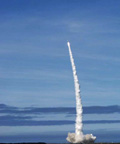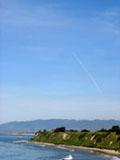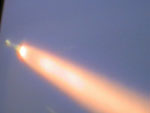WEEKLY HIGHLIGHTS FOR 24 APRIL 2004:
GRAVITY PROBE B MISSION UPDATE
- At 9:57:24 am Pacific Daylight Time on Tuesday, April 20, 2004, the Gravity
Probe B spacecraft had a picture-perfect launch from Vandenberg Air Force Base
in South-central California. The Boeing Delta II rocket hit the exact center
of the bull's eye in placing the spacecraft in its target polar orbit, 400
miles above the Earth.
 Click
here to view a 3 1/2 minute QuickTime video clip of the GP-B launch, produced
by the Stanford News Service. Please note that the video requires Quick Time to play.
Click here to
link to
download Quick Time.
Click
here to view a 3 1/2 minute QuickTime video clip of the GP-B launch, produced
by the Stanford News Service. Please note that the video requires Quick Time to play.
Click here to
link to
download Quick Time.
- At approximately one hour eleven minutes, the spacecraft's solar arrays deployed, and shortly thereafter, the on-board cameras treated all viewers, via NASA TV, to the extraordinary sight of the separation of the spacecraft from the second stage rocket, with a portion of the Earth illuminated in the background.
- After three days in orbit, all Gravity Probe B systems are performing as planned. The solar arrays are generating power, and all electrical systems are powered on. The spacecraft is communicating well with the Tracking and Data Relay Satellite System (TDRSS) and supporting ground stations.
- All four Gyro Suspension Systems have now been activated. In addition, a lift check was successfully accomplished for gyros #2 and #3. This was the first ever levitation of a Gravity Probe B gyro on orbit."
- The spacecraft's Attitude Control System is maintaining initial attitude control. Fine attitude control should be achieved when thruster calibrations have been completed. After that, the ultra-precise science telescope will be locked onto the Gravity Probe B guide star, IM Pegasi, to within a range of 1/100,000th of a degree.



 The spacecraft is being controlled from the Gravity Probe B Mission Operations
Center, located here at Stanford University. The Initialization & Orbit
Checkout (IOC) phase of the Gravity Probe B mission is planned to last 45-60
days, after which the 12-month science data collection will begin.
The spacecraft is being controlled from the Gravity Probe B Mission Operations
Center, located here at Stanford University. The Initialization & Orbit
Checkout (IOC) phase of the Gravity Probe B mission is planned to last 45-60
days, after which the 12-month science data collection will begin.
Throughout the Initialization & Orbit Checkout (IOC), we will update this Web site and our GP-B email list weekly, or more often as necessary, to report any changes in status or noteworthy GP-B events.
TRACKING THE GP-B SPACECRAFT
Find the Gravity Probe B satellite in the sky at NASA's satellite tracking web site. See where GP-B is with respect to the terminator (the day-night boundary on the Earth's surface), or just enter your zip code to see if GP-B might be over your neighborhood. The best time to look for it is usually at dusk.
DOWNLOAD THE GRAVITY PROBE B LAUNCH COMPANION

 We have prepared a short document that provides an overview and explanation
of the Gravity Probe B experiment and information about the spacecraft and
GP-B's amazing technologies, plus information about the mission and post-launch
events. Click
here to download the GP-B Launch Companion in Adobe Acrobat PDF format.
(Please note: this file is 1.6 MB, so it may take awhile to download if you
have a
slow Internet connection.)
We have prepared a short document that provides an overview and explanation
of the Gravity Probe B experiment and information about the spacecraft and
GP-B's amazing technologies, plus information about the mission and post-launch
events. Click
here to download the GP-B Launch Companion in Adobe Acrobat PDF format.
(Please note: this file is 1.6 MB, so it may take awhile to download if you
have a
slow Internet connection.)
FOLLOWING THE GP-B MISSION ON THE WEB
In addition to this Web site, here are some other Web sites that have information, photos, and video of the GP-B launch and mission.
- The ELV Missions Virtual Launch Center Web page on the John F. Kennedy Space Center Web site has information and several streaming video clips covering the GP-B mission. (You can view these video clips free of charge, but you will need to have either the Real Media Player or Windows Media Player installed on your computer to view them.)
- NASA's Marshall Space Flight Center Gravity Probe B.com Web page has a number of great photos from the GP-B launch, including photos of the spacecraft separation, as well as other information about Gravity Probe B.
- Photographer William G. Hartenstein's Web site has an extraordinary set of photos that he took on launch day.
- Another very comprehensive source of information about the GP-B launch is the Spaceflight Now Web site. This site contains an excellent photo gallery, as well as a number of Quicktime video clips of the launch. However, you have to become a subscriber to this site ($$$) in order to view the video clips.
Photos: The first photo, showing the Delta II rocket and payload lifting off of the launch pad was taken by a photographer from the Boeing Corporation. The second photo, showing the rocket in the air, at the end of its vapor trail, was taken by Jim Burns, a member of the Stanford GP-B team at Vandenberg AFB. The shot of the rocket's vapor trail high above the coastline was sent to us by John Dickson of SantaBarbara.com. Thank you John! The photos of the rocket engine glow and the two photos showing the spacecraft separating from the second stage rocket were extracted from NASA KSC's launch video. Click on the thumbnails to view enlarged copies of these photos.
GRAVITY PROBE B IN THE NEWS
Sunday evening, April 18th, a feature story about Gravity Probe B and principal investigator, Francis Everitt, aired on ABC World News Tonight. Click here to read a text version of the ABC News story. Also on April 18th, NPR's David Kestenbaum talked with GP-B's principal investigator, Francis Everitt on the program All Things Considered. On Friday, April 16th, Gravity Probe B Co-Principal Investigator, John Turneaure, was interviewed by Ira Flatow on NPR Talk of the Nation—Science Friday.
On Tuesday, April 13,2004, Gravity Probe B was the lead story in the Science section of the New York Times, and it was one of the front page stories in the San Jose Mercury News. (You'll need to register on the Web sites of these newspapers to view these stories online.) In addition, a story about GP-B appeared on the New Scientist Web on April 13, 2004.
The official pre-launch Gravity Probe B mission and science briefing was held on Friday, April 2, 2004 at 1:00 PM Eastern Daylight Time at NASA Headquarters in Washington, D.C. The participants in the briefing (pictured from left to right in the photo) were:

- Anne Kinney, Director of Astronomy/Physics Division, NASA Headquarters
- Rex Geveden, Program Manager, GP-B and Deputy Director, NASA's Marshall Space Flight Center in Huntsville, Alabama.
- Francis Everitt, GP-B Principal Investigator at Stanford University, Stanford, California
- Bradford Parkinson, GP-B Co-Principal Investigator at Stanford University, Stanford California
- Kip Thorne, Feynman Professor of Theoretical Physics, California Institute of Technology, Pasadena, California
You can view a Real Player streaming video of this briefing on the Kennedy Space Center GP-B Web site.
Following this press briefing, stories about Gravity Probe B appeared in a number of newspapers around the country. For example:
- The Boston Globe carried a front page story, which you can read online.
- The San Francisco Chronicle carried a front page story, which you can read online.
- On the Internet, a story about GP-B, written by Associated Press science writer Andrew Bridges, became one of April 3rd's most popular stories on Yahoo News.
- CNN also ran a story about GP-B, which you can view online.
RECEIVE GRAVITY PROBE B WEEKLY HIGHLIGHTS BY EMAIL
If you are interested in automatically receiving these weekly highlights and other important GP-B mission information by email, you can subscribe to our Gravity Probe B Update email list by sending an email message to "majordomo@lists.Stanford.edu" with the command "subscribe gpb-update" in the body of the message (not in the Subject line). You can unsubscribe from this mailing list at any time by sending an email message to the same address with the command, "unsubscribe gpb-update" in the body of the message.
Previous Highlight
Index of Highlights
